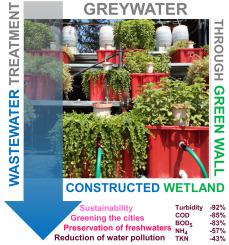Science of the Total Environment ( IF 9.8 ) Pub Date : 2020-12-04 , DOI: 10.1016/j.scitotenv.2020.144189 Nicola Dal Ferro , Chiara De Mattia , Mario Andres Gandini , Carmelo Maucieri , Piergiorgio Stevanato , Andrea Squartini , Maurizio Borin

|
An increase in water use in urban areas is forcing scientists and policy makers to find alternative solutions for freshwater management, aimed at attaining integrated water resources management. Here, we tested in a 2-year experiment (June 2017-April 2019) the treatment performance of an innovative wall cascade constructed wetland (WCCW) system. The aim was to combine the multifunctional benefits of green walls (e.g. aesthetic, surface area requirements) with those of constructed wetland systems (e.g. high pollutants removal efficiencies, water recycling) to treat kitchen greywaters. The WCCW was a terraced system of six phytoremediation lines, each of which was composed of three plastic tanks (3 × 0.04 m3), filled with lightweight porous media, and vegetated with different ornamental species, namely Mentha aquatica L., Oenanthe javanica (Blume) DC., and Lysimachia nummularia L. Physicochemical (temperature, pH, electrical conductivity, dissolved oxygen, turbidity) and chemical parameters (chemical oxygen demand, biochemical oxygen demand, anionic surfactants, Kjeldahl, ammonium and nitric nitrogen, total orthophosphate) were monitored at a frequency of at least 15 days, depending on the season and WCCW management. Results showed that the WCCW significantly reduced the main water pollutants (e.g. organic compounds, nutrients), suggesting its potential application in urban environments for water recycling in the context of green infrastructures and ecological sanitation. A culture-independent taxonomic assessment of suspended bacterial communities before and after the treatment showed clear treatment-related shifts, being the functional ecology attributes changed according to changes in greywater chemical parameters. Future research should attempt to optimize the WCCW system management by regulating the nutrients balance to avoid macronutrients deficiency, and setting the most suitable water flow dynamics (hydraulic retention time, saturation-desaturation cycles) to improve the greywater treatment.
中文翻译:

绿墙处理城市地区的厨房灰水:中试规模的性能
城市地区用水量的增加正迫使科学家和政策制定者寻找淡水管理的替代解决方案,以实现水资源综合管理。在这里,我们在为期2年的实验(2017年6月至2019年4月)中测试了创新的墙体级联人工湿地(WCCW)系统的处理性能。目的是将绿墙的多功能益处(例如,美学,表面积要求)与人工湿地系统的益处(例如,较高的污染物去除效率,水循环利用)相结合,以处理厨房灰水。WCCW是一个由6条植物修复线组成的梯田系统,每条植物线由3个塑料槽(3×0.04 m 3)组成,装有轻质多孔介质,并装有不同的观赏物种,即薄荷(Mentha aquatica L.),爪哇Oenanthe Javanica(Blume)和金钱草(Lysimachia nummularia)L.以至少15的频率监测物理化学物质(温度,pH,电导率,溶解氧,浊度)和化学参数(化学需氧量,生化需氧量,阴离子表面活性剂,凯氏定氮素,铵和硝态氮,总正磷酸盐)天数,具体取决于季节和WCCW管理。结果表明,WCCW大大减少了主要的水污染物(例如有机化合物,养分),表明其在绿色基础设施和生态卫生的背景下在城市环境中进行水循环利用的潜在应用。治疗前后悬浮细菌群落的文化独立分类学评估显示了与治疗相关的明显变化,即功能生态属性随灰水化学参数的变化而变化。



























 京公网安备 11010802027423号
京公网安备 11010802027423号